
Original Link: https://www.anandtech.com/show/1580
Corsair 4400C25: Taking Samsung TCCD to New Heights
by Wesley Fink on January 4, 2005 12:05 AM EST- Posted in
- Memory
In June of 2004, Corsair 3200XL appeared on the market. It was the first time since the death of Winbond BH5 that we had seen a memory with 2-2-2 timings at DDR400. More than that, this new memory also proved to reach DDR500 performance levels - something that Winbond BH5 could never do. That performance first seen in The Return of 2-2-2: Corsair 3200XL & Samsung PC4000 soon became a deluge as almost every memory manufacturer introduced their own version of high-speed DDR memory based on Samsung TCCD memory chips.
Along the way, we saw many innovations, as discussed in =F-A-S-T= DDR Memory: 2-2-2 Roars on the Scene and Geil PC3200 Ultra X: High Speed & Record Bandwidth. The revolutionary performance of that first Corsair 3200XL soon became average as memory makers tried to out-do each other with new PCB's and SPD programming that squeezed even more out of the Samsung TCCD chips. It seemed almost overnight that the Samsung TCCD became the high-speed standard for DDR memory.
What many may have forgotten along the way is that Samsung never really rated TCCD as a DDR400 memory chip. In the Samsung catalogs, TCCD was listed as a DDR500 part, and the higher costs also went along with Samsung's classification as DDR500. Most manufacturers binned (speed-sorted) the Samsung TCCD, and the parts that could do 2-2-2 at DDR400 went into the best memory. In fact, not all of the Samsung TCCD chips can do DDR400 2-2-2 timings, and some of the very best performers at very high DDR speeds simply will not do 2-2-2 timings at DDR400.
This background is to put into perspective Corsair's latest memory offering, XMS4404v1.1. This new memory is based on Samsung TCCD chips, but it is rated at PC4400 or DDR550. Corsair has targeted this memory at the highest DDR speeds achievable on the DDR platform, and the design, from top to bottom, is to reach the highest DDR speeds possible on the Intel Socket 478 and AMD Athlon 64 platforms. Does Corsair succeed in their design goal? To determine that, the performance of Corsair PC4400 is compared to the best TCCD DIMMs tested at AnandTech.
Corsair PC4400
Corsair is the most universally-recognized brand of enthusiast memory. However, for quite a while, Corsair had no interest in being included in comparative memory roundups as they referred to themselves as "the BMW of memory providers". There was even a period of time where Corsair refused to provide review samples to websites that did reviews comparing Corsair memory to other brands. Fortunately, the thinking at Corsair has changed in the last few months, and Corsair is again actively sampling websites like AnandTech, which insist that comparisons are the best way to evaluate products. We are really glad that Corsair is active in AnandTech memory reviews again, and we were very excited to see what Corsair had done at the high end with their new DDR550 memory.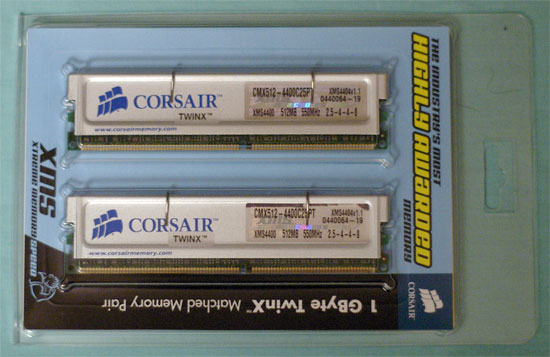
As you can see in the photo, the DIMMs are identified as CMX512-4400C25P with an ID of XMS 4404v1.1. Corsair supplies the new DDR550 memory as a matched pair of SS 256MB, called TwinX512-4400C25, and as a matched pair of double-sided 512MB DIMMs, identified as TwinX1024-4400C25. For testing, Corsair supplied a pair of double-sided 512MB DIMMs with aluminum platinum-colored heatspreaders. This 1GB pair is the same configuration tested in other AnandTech reviews of Samsung TCCD memory.

The DIMMs are mounted on a PCB that appears identical to a PCB used on a few other top TCCD DIMMs. The PCB ID is BP MLL E186014, which appears to be the top performing Brainpower PCB used by OCZ, Geil and G. Skill, just to name a few. This PCB has developed quite a reputation for top performance at high speeds with Samsung TCCD, so we expect great high-end results from this Corsair DDR550. Those of you wondering how to identify a Brainpower PCB will be pleased to know that it is distinguishable by just 8 components along the lower edge of the back side of the DIMM - just above the slot fingers. Most other PCBs that we have seen used with TCCD are strewn with components along this edge on both sides. This quick ID method will change with future designs, but if you see DIMM side with just a very few components above the slot, it is likely the brainpower PCB.
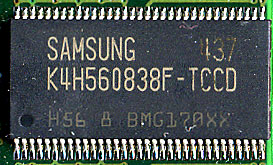
With the heatspreader removed, you can also clearly see that the memory chips are definitely Samsung TCCD. As you will see in our review, the behavior curve for this Corsair DDR550 is a bit different than what you have seen in other TCCD reviews. We wanted to make sure that we were indeed dealing with Samsung TCCD and not some new variant of Hynix chips or a special unlabeled bin developed by a chip manufacturer for Corsair.
| Corsair PC4400 Specifications | |
| Number of DIMMs & Banks | 2 DS |
| DIMM Size Total Memory |
512 MB |
| Rated Timings | 2.5-4-4-5 at DDR550 Typically 2-2-2-5 at DDR400 |
| SPD (Auto) Timings | 2.5-4-4-8 |
| Rated Voltage | 2.75V |
With Intel's introduction this summer of the Intel 915/95 chipsets with support for DDR2 memory, the primary market for DDR memory has become the excellent AMD Athlon 64 platform. However, some 915 boards also support DDR, and the continuing Intel Socket 478 also supports DDR memory. For these reasons, Corsair DDR550 was tested on both the standard Intel 478 memory test bed and our newest Athlon 64 Socket 939 test bed.
AMD Performance Test Configuration
The Corsair TwinX1024-4400C25 were first tested on the new Athlon 64 memory test bed. You can find more information on the new memory test setup in Athlon 64 Memory: Rewriting the Rules.The A64 test bed includes components that have been proven in Socket 939 Athlon 64 benchmarking, such as the Gold Editors Choice MSI K8N Neo2, the completely unlocked Socket 939 FX53, and the OCZ Power Stream 520 Power Supply. Since the Athlon 64 tests represent a new series of DDR testing, we have chosen the current generation nVidia 6800 Ultra video card for benchmarking. We have found the 6800 Ultra to be a particularly good match to nVidia nForce3 Ultra motherboards.
All other basic test conditions attempted to mirror those used in our earlier Intel memory reviews. However, test results are not directly comparable to tests performed on the Intel test bed.
| AMD nForce3 Ultra Performance Test Configuration | |
| Processor(s): | AMD FX53 Athlon 64 (2.4GHz, Socket 939, Dual Channel, 1000HT) |
| RAM: | Corsair TwinX1024-4400C25 (DS) 2X512MB G. Skill TCCD (DS) 2X512MB PQI 3200 Turbo (DS) 2X512MB Crucial Ballistix (DS) 2X512MB Geil PC3200 Ultra X (DS) 2X512MB OCZ PC3200 Platinum Rev 2 (DS) 2X512MB OCZ PC3700 Gold Rev 3 (DS) 2X512MB |
| Hard Drives | Seagate 120GB PATA (IDE) 7200RPM 8MB Cache |
| PCI/AGP Speed | Fixed at 33/66 |
| Bus Master Drivers: | nVidia nForce Platform Driver 4.24 (5-10-2004) |
| Video Card(s): | nVidia 6800 Ultra 256MB, 256MB aperture, 1024x768x32 |
| Video Drivers: | nVidia Forceware 61.77 |
| Power Supply: | OCZ Power Stream 520W |
| Operating System(s): | Windows XP Professional SP1 |
| Motherboards: | MSI K8N Neo2 |
We have found the fastest performance on AMD Athlon 64 chipsets (nForce3, VIA K8T800 PRO) to be achieved at Cycle Time or tRAS of 10. Athlon 64 platform benchmarks were therefore run with the tRAS timing of 10 for all A64 benchmarks.
Test Settings
The FX53 is completely unlocked, which allows a different approach to memory testing that truly measures performance differences in memory speed alone. All tests were run with CPU speed as close to the specified 2.4GHz of the FX53 as possible, with CPU speed/Memory Speed increased at lower multipliers to achieve 2.4Ghz. This approach allows the true measurement of the impact of higher memory speed and timings on performance, since CPU speed is fixed, removing CPU speed as a factor in memory performance.The following settings were tested with the Corsair DDR550 on the Athlon 64 test bed:
- 12x200/DDR400 - the highest stock memory speed supported on K8T800-Pro/nF3-4/SiS755-FX motherboards.
- 11x218/DDR436 - a ratio near the standard DDR433 speed
- 10x240/DDR480 - a ratio near the standard rating of DDR466
- 9x267/DDR533 - a standard memory speed used in testing other high-speed memory
- Highest Memory Speed - the highest memory speed that we could achieve regardless of the multiplier. This setting was generally achieved at a 2T command rate and performance is often poorer than slower memory timings at a 1T Command Rate.
- Highest Performance - the highest memory performance settings that we could achieve. This setting is normally the highest stable speed using a 1T Command Rate.
We ran our standard suite of memory performance benchmarks: Quake 3, Return to Castle Wolfenstein-Enemy Territory-Radar, Super Pi 2M, and Sandra 2004 Standard and UnBuffered. Since the results for Athlon 64 tests are new, we are now including Sandra Buffered (Standard) test results and Sandra UnBuffered test results. RTCW Enemy Territory has also been added as a standard memory benchmark.
Intel Performance Test Configuration
The Corsair TwinX1024-4400C25 was also tested in our standard Intel Pentium 4 Memory testbed. The hardware is the same used in our earlier reviews of DDR400 and faster Memory. All test conditions were as close as possible in these tests over time on the Intel test bed. We also eliminated from our charts any known memory that has been discontinued.| INTEL 875P Performance Test Configuration | |
| Processor(s): | Intel Pentium 4 2.4GHz (800MHz FSB) |
| RAM: | 2X512MB Corsair TwinX1024-4400C25 (DS) 2X512MB G. Skill TCCD (DS) 2X512MB PQI 3200 Turbo (DS) 2X512MB OCZ PC3700 Gold Rev 3 (DS) 2X512MB Geil PC3200 Ultra X (DS) 2X512MB Crucial Ballistix PC3200 (DS) 2X512MB Kingston HyperX PC3200 L-L (DS) 2X512MB Mushkin PC3200 Level II V2 (DS) 2X512MB OCZ PC3200 Platinum Rev. 2 (DS) 2X512MB Corsair 3200XL PRO (DS) 2X256MB Samsung PC4000 (SS) 2X512MB Buffalo FireStix PC4000 (DS) 2X512MB Shika XRAM PC4400 (DS) 2X512MB OCZ PC4400 EL Gold (DS) 2X512MB OCZ 3700EB (DS) 2X512MB OCZ 3500EB (DS) 2X512MB Mushkin 2-2-2 Special (DS) 2X512MB PMI4200 Gold (DDR533 DS) 4X256MB Samsung PC3700 (DDR466 SS) 2X512MB Kingmax DDR500 Hardcore Series (DS) 2X512MB Kingmax DDR466 Hardcore Series (DS) 2X512MB Corsair XMS4400v1.1 TwinX (DS) 2X512MB OCZ PC4400 DC Kit (DS) 2X512MB OCZ 4200EL(DS) 2x512MB Mushkin PC4000 High Performance (DS) 2X512MB Corsair TwinX4000 PRO (DS) 2X256Mb Adata DDR450 (SS) 2X512MB Adata PC4000 (DS) 2X512MB Corsair PC4000 (DS) 2X512MB Geil PC4000 (DS) 2X512MB OCZ PC4000 (DS) |
| Hard Drives | 2 Western Digital Raptor Serial ATA 36.7GB 10,000RPM drives in an Intel ICH5R RAID configuration |
| PCI/AGP Speed | Fixed at 33/66 |
| Bus Master Drivers: | 875P Intel INF Update v5.00.1012, SATA RAID drivers installed, but IAA not installed |
| Video Card(s): | ATI 9800 PRO 128MB, 128MB aperture, 1024x768x32 |
| Video Drivers: | ATI Catalyst 4.10 |
| Power Supply: | Vantec Stealth 470 Watt Aluminum |
| Operating System(s): | Windows XP Professional SP1 |
| Motherboards: | Asus P4C800-E (875) with 1016 Release BIOS |
We have found the fastest performance on Intel 865/875 to be achieved at Cycle Time or tRAS of 5, or the fastest tRAS setting that is stable with the tested memory. Intel platform benchmarks were therefore run with the fastest stable tRAS timings that we could achieve with the Corsair 4400C25.
Test Settings
We ran our standard suite of memory performance benchmarks. The following settings were tested with the Corsair DDR550 memory:- 800FSB/DDR400 - the highest stock speed supported on 875/865 and K8T800/nF3/SiS755 motherboards. The rated speed of both G. Skill TCCD and PQI 3200 Turbo.
- 866FSB/DDR433 - a speed rating that we have used in testing other low-latency DDR400 memory.
- 933FSB/DDR466 - a standard memory speed also specified as PC3700.
- 1000FSB/DDR500 - a standard memory speed used in testing other high-speed memory and the rated speed of OCZ PC4000 Gold Rev. 2
- 1066FSB/DDR533 - a standard memory speed included for comparison
- Highest Stable Overclock - the highest settings that we could achieve with this memory and other memory that we have tested.
Test Results: Corsair XMS4404v1.1
To be considered stable for test purposes, Quake3 benchmark, UT2003 Demo, Super PI, Aquamark 3, and Comanche 4 had to complete without incident. Any of these, and in particular Super PI, will crash a less-than stable memory configuration.AMD Test Results
| Corsair XMS4404v1.1 (DDR550) - 2x512Mb Double-Bank | |||||||
| CPU Ratio at 2.4GHz | Memory Speed | Memory Timings & Voltage |
Quake3 fps |
Sandra UNBuffered | Sandra Standard Buffered |
Super PI 2M places (time in sec) |
Wolfenstein - Radar - Enemy Territory fps |
| 12x200 | 400 DDR | 2-3-3-10 2.5V 1T |
501.0 | INT 2641 FLT 2764 |
INT 6051 FLT 601 |
82 | 108.2 |
| 11x218 | 436 DDR | 2-3-3-10 2.6V 1T |
510.1 | INT 2680 FLT 2855 |
INT 6439 FLT 6372 |
81 | 109.7 |
| 10x240 | 480 DDR | 2-3-3-10 2.75V 1T |
522.7 | INT 2903 FLT 3095 |
INT 6684 FLT 6609 |
80 | 112.0 |
| 9x267 | 533 DDR | 2.5-3-3-10 2.75V 1T |
533.3 | INT 3045 FLT 3266 |
INT 6972 FLT 6885 |
78 | 113.3 |
| 8x305 (2.44GHz) |
Highest 1T Mem Speed 610 DDR |
2.5-3-4-10 2.8V 1T |
569.2 | INT 3248 FLT 3467 |
INT 7531 FLT 7441 |
77 | 116.6 |
| 8x318 (2.54GHz) |
Highest 2T Mem Speed 636 DDR |
3-4-4-10 2.85V 2T |
568.7 | INT 3088 FLT 3149 |
INT 7011 FLT 7549 |
76 | 122.6 |
| 9x295 (2.75GHz) |
Highest Performance 590 DDR |
2.5-4-3-10 2.8v 1T |
572.8 | INT 3346 FLT 3538 |
INT 7712 FLT 7549 |
72 | 122.9 |
Corsair handily turns in the highest memory performance that we have yet seen on the Athlon 64. The highest 2T value of DDR636, the Highest 1T value of 610, and the Top Performance of 9x295 at 1T are all records on the AMD platform. It is clear that Corsair aimed for best performance at the top with this DDR550 memory, since performance at DDR400 is not up to the same standards achieved at the top. Corsair says that modules will typically do 2-2-2 timings at DDR400, but the best that we could do at any voltage is 2-3-3 at DDR400. Corsair selected Samsung TCCD chips for absolute best performance at the top and they clearly succeeded in reaching this goal. The compromise was a bit less performance at DDR400 - at least with the modules we tested.
Intel Test Results
| Corsair XMS4404v1.1 (DDR550) - 2x512Mb Double-Bank | ||||||
| Speed | Memory Timings & Voltage |
Quake3 fps |
Sandra UNBuffered | Sandra Standard Buffered |
Super PI 2M places (time in sec) |
RCW-ET fps |
| 400DDR 800FSB |
2-3-3-5 2.5V |
331.0 | INT 2720 FLT 2728 |
INT 4457 FLT 4453 |
130 | 70.1 |
| 433DDR 866FSB |
2-3-3-5 2.55V |
358.1 | INT 2910 FLT 2827 |
INT 4784 FLT 4802 |
120 | 77.4 |
| 466DDR 933FSB |
2-3-3-5 2.65V |
384.5 | INT 3107 FLT 3187 |
INT 5162 FLT 5189 |
112 | 83.0 |
| 500DDR 1000FSB |
2-3-3-5 2.75V |
409.1 | INT 3348 FLT 3396 |
INT 5567 FLT 5561 |
104 | 89.6 |
| 533DDR 1066FSB |
2.5-3-3-5 2.75V |
430.3 | INT 3580 FLT 3623 |
INT 5947 FLT 5851 |
98 | 94.9 |
| 572DDR 1144FSB |
2.5-4-4-6 2.85V |
450.1 | INT 3763 FLT 3799 |
INT 6348 FLT 6273 |
93 | 97.8 |
The pattern is similar on the Intel memory platform, although the domination by Corsair at the top of the performance charts is not nearly so clear. Corsair lags the best TCCD memory in performance at DDR400, but by DDR466, the superior high-end performance of Corsair DDR550 has established itself. As speed further increases, the advantage of the Corsair DDR550 widens.
After looking at both Intel and AMD performance results, it is obvious that Corsair has binned Samsung TCCD for this memory with the clear goal of performance at the top. Corsair rating the memory at DDR550 instead of the DDR400 used in most other TCCD memory is clearly justified with this emphasis on the top-end of memory performance. Corsair had to compromise DDR400 performance a bit - at least on the modules that we tested - to achieve the incredible top-end results that we see in these benchmarks.
Performance Comparisons
Performance of the Corsair TwinX1024-4400C25 was compared to all of the memory recently tested on both the AMD Athlon 64 test bed and the Intel 875 memory test bed in:PQI & G. Skill: New Choices in 2-2-2 Memory
Athlon 64 Memory: Rewriting the Rules
OCZ 3700 Gold Rev. 3: DDR500 Value for Athlon 64 & Intel 478
Geil PC3200 Ultra X: High Speed & Record Bandwidth
=F-A-S-T= DDR Memory: 2-2-2 Roars on the Scene
Buffalo FireStix: Red Hot Name for a New High-End Memory
New DDR Highs: Shikatronics, OCZ, and the Fastest Memory Yet
The Return of 2-2-2: Corsair 3200XL & Samsung PC4000
OCZ 3700EB: Making Hay with Athlon 64
OCZ 3500EB: The Importance of Balanced Memory Timings
Mushkin PC3200 2-2-2 Special: Last of a Legend
PMI DDR533: A New Name in High-Performance Memory
Samsung PC3700: DDR466 Memory for the Masses
Kingmax Hardcore Memory: Tiny BGA Reaches For Top Speed
New Memory Highs: Corsair and OCZ Introduce DDR550
OCZ PC3700 Gold Rev. 2: The Universal Soldier
OCZ 4200EL: Tops in Memory Performance
Mushkin PC4000 High Performance: DDR500 PLUS
Corsair TwinX1024-4000 PRO: Improving DDR500 Performance
Mushkin & Adata: 2 for the Fast-Timings Lane
Searching for the Memory Holy Grail - Part 2
AMD Memory Comparisons
Corsair TwinX1024-4400C25 was compared to other memory included in our recent Athlon 64 Memory Roundup. Memory performance was compared at 200x12 (2.4Ghz, DDR400), 218x11 (2.4Ghz, DDR438), 240x10 (2.4Ghz, DDR480), 267x9 (2.4Ghz, DDR533), the Highest Memory Speed that could be reached, and the Highest Memory Performance Settings that we could reach. With a constant CPU speed, memory comparisons show the true impact of faster speed and slower memory timings on memory performance.Intel Memory Comparisons
For easier comparison to other TCCD memory on the Intel platform, we have color-coded memory from revent reviews of DDR400 2-2-2 memory in light green. Memory in those reviews are predominately based on Samsung TCCD memory chips. Memory performance was compared at DDR400, DDR433, DDR466, DDR500, DDR533 (where possible), and the highest stable overclock that we could achieve, which would run Quake 3, UT2003, and Super PI to 2MM places.Results are compared for Quake 3, Sandra UNBufferred Memory Test, and Super PI. SiSoft Sandra 2004 reports 2 results for each memory test - an Integer value and a Float value. Results reported in our charts are the result of averaging the INT and FLOAT scores, which are normally close in value. In other words, INT and FLOAT scores were added and divided by 2 for our reported score.
AMD DDR400/2.4GHz Performance
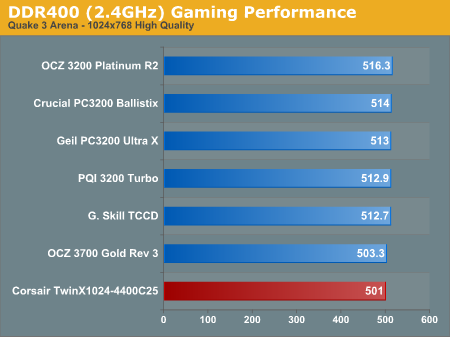
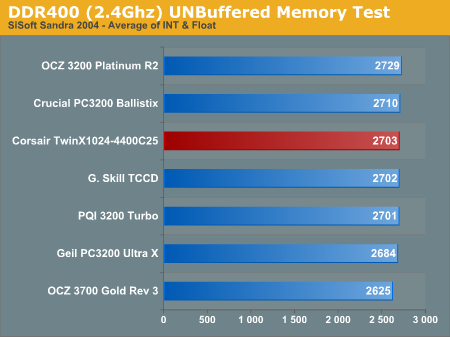
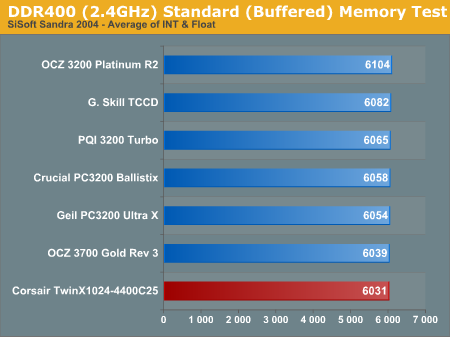
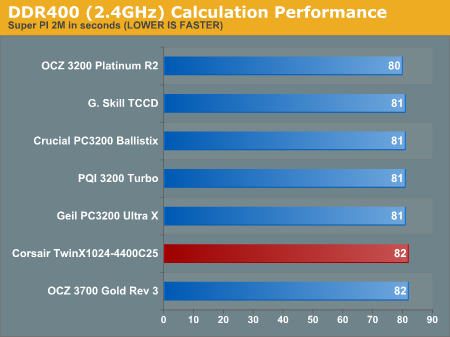
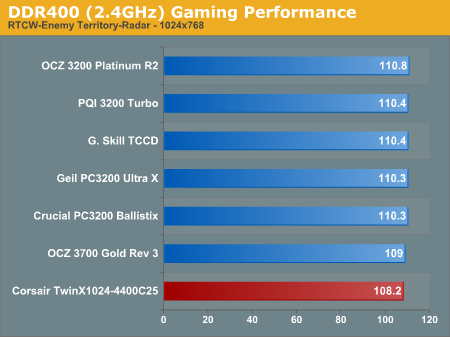
AMD DDR436/2.4GHz
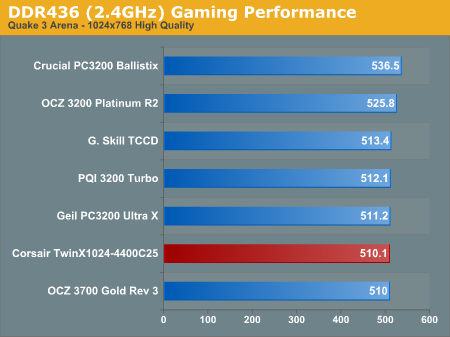
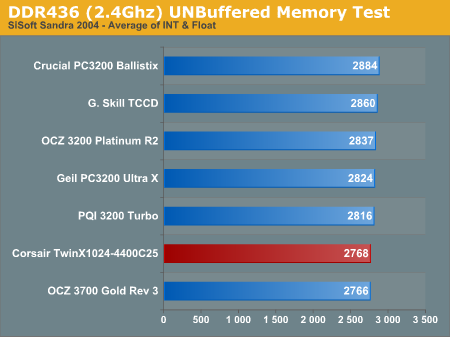
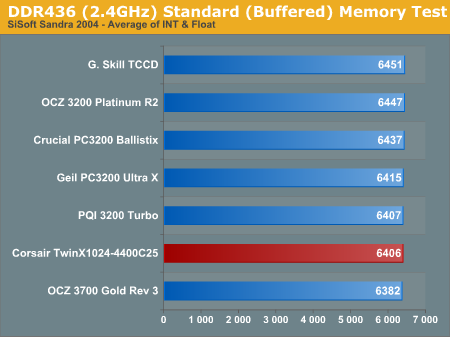

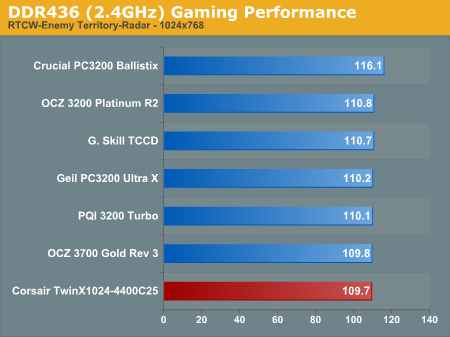
AMD DDR480/2.4GHz

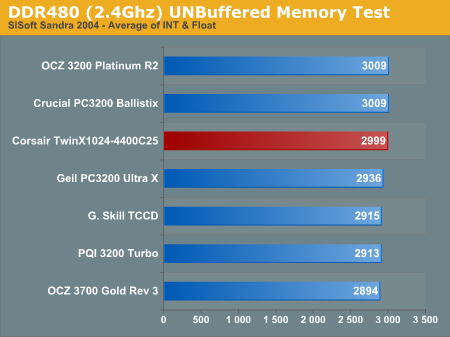

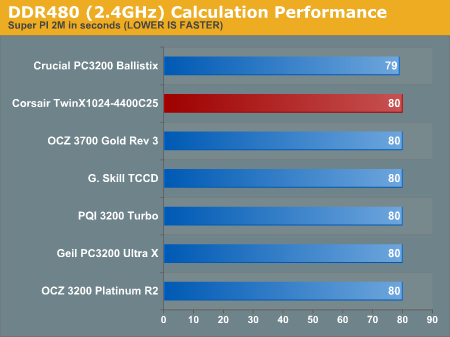
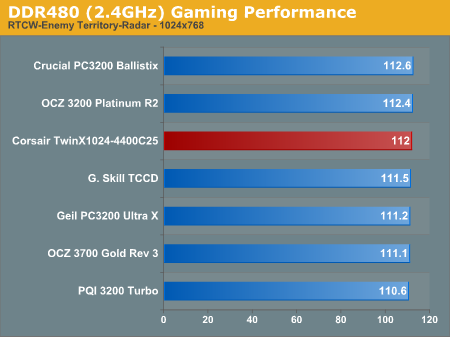
AMD 533/2.4GHz
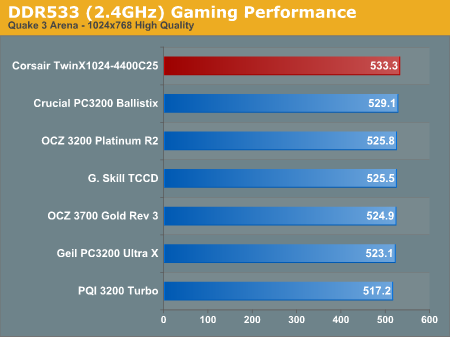
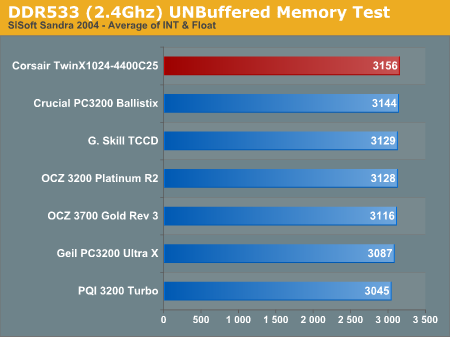
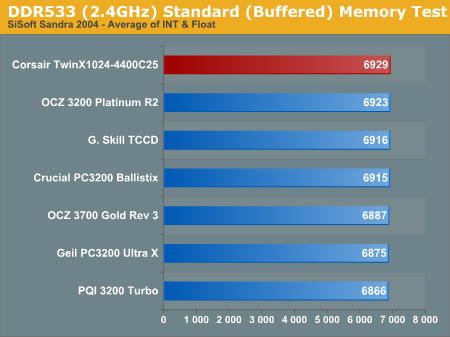
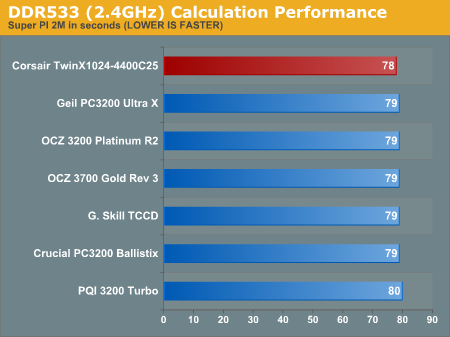
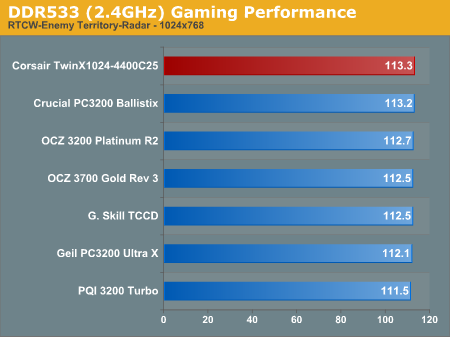
AMD Highest Memory Speed
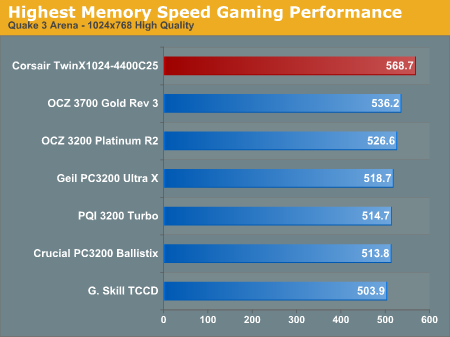
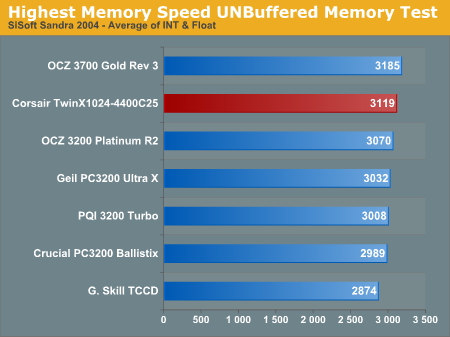
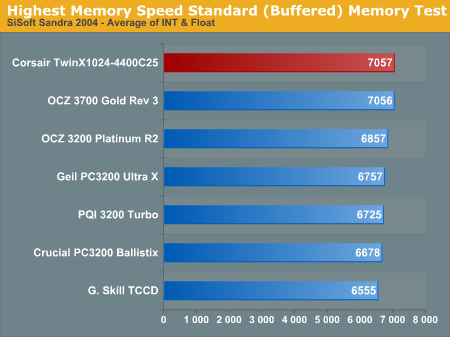

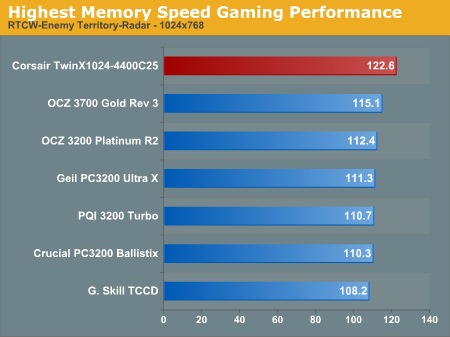
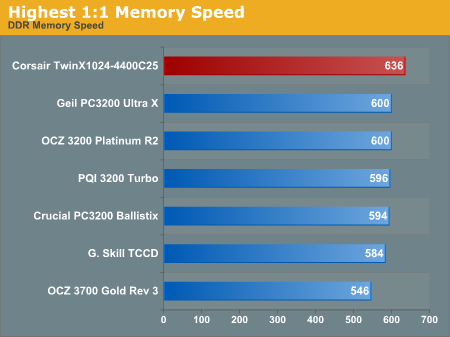
AMD Highest Performance
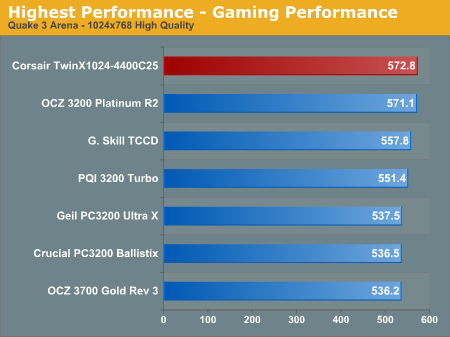
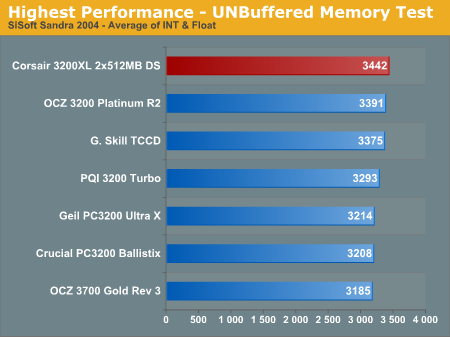
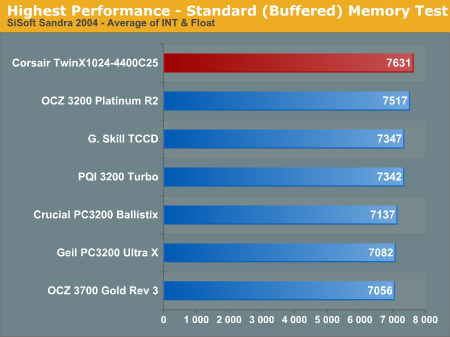
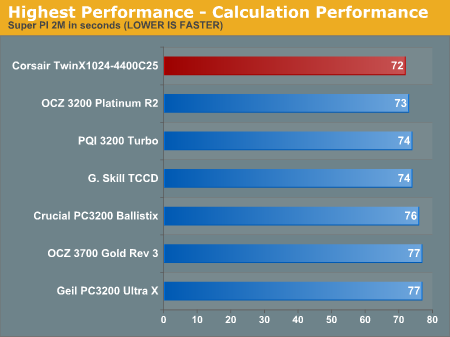
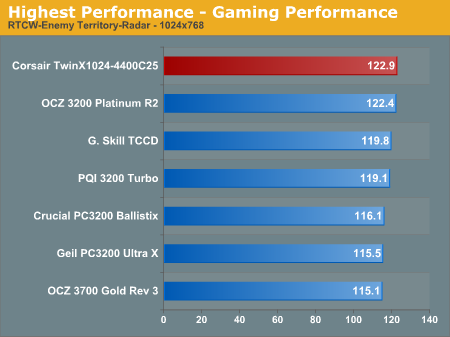

Intel DDR400 Performance
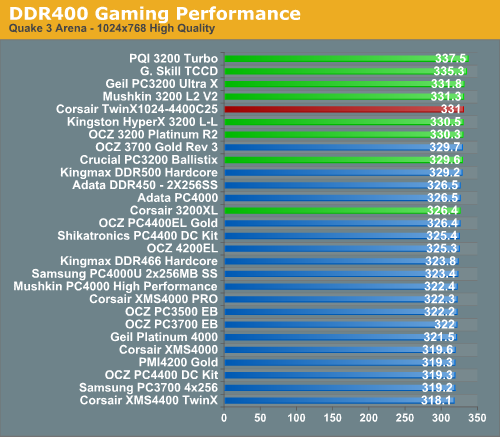

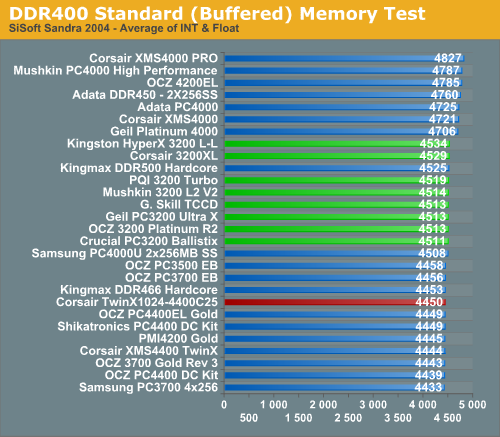

Intel DDR433 page 14

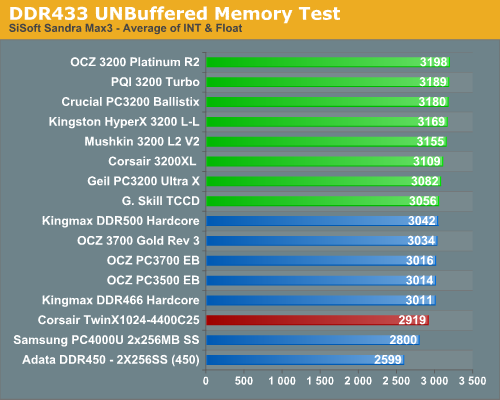
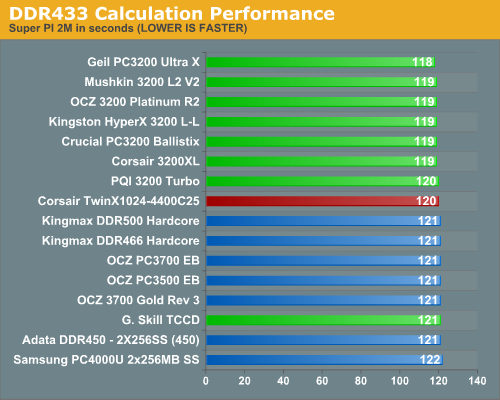
Intel DDR466
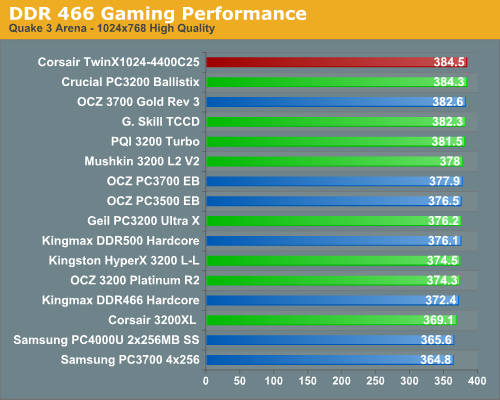
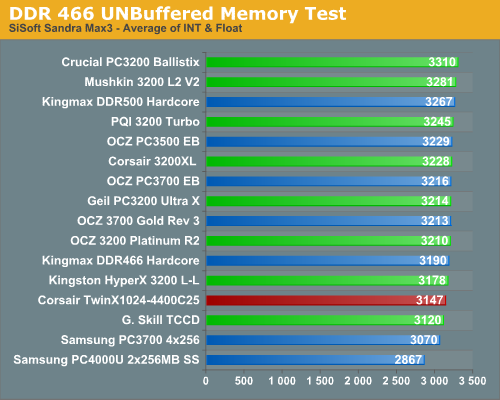
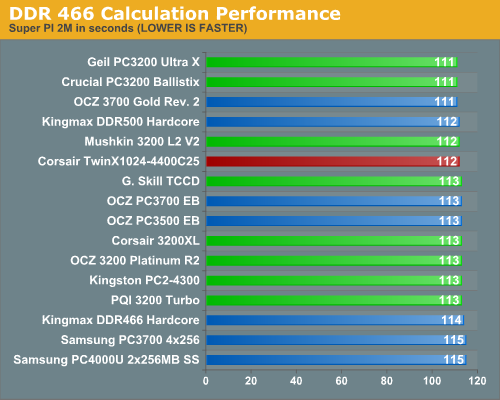
Intel DDR500
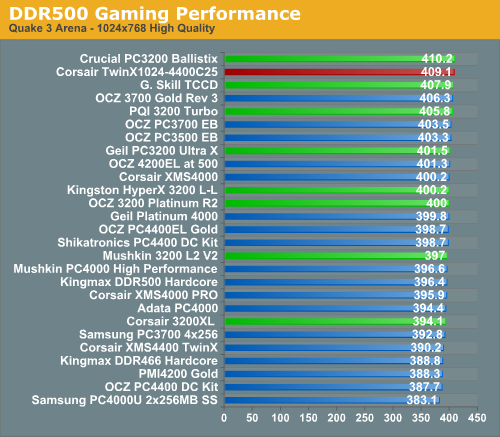
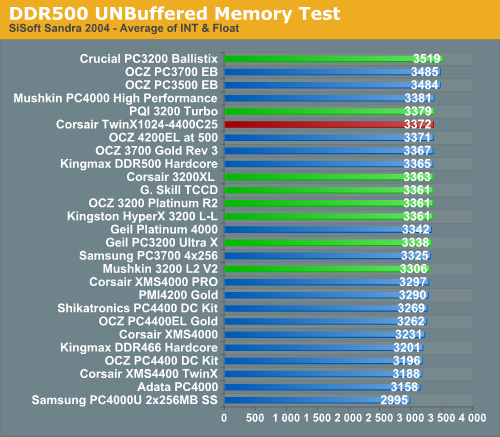
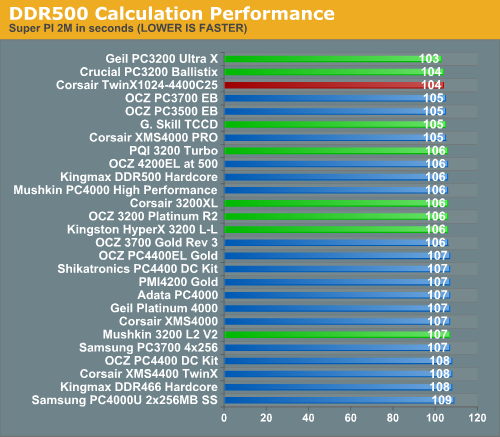
Intel DDR533
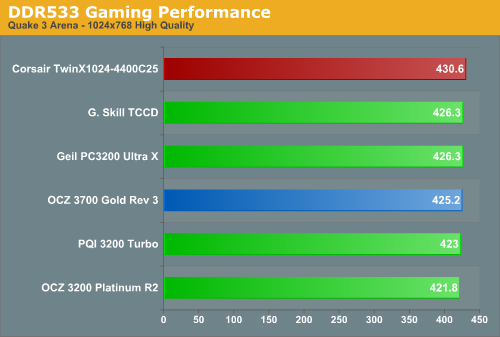
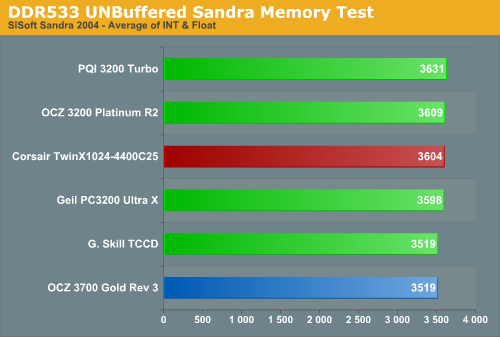
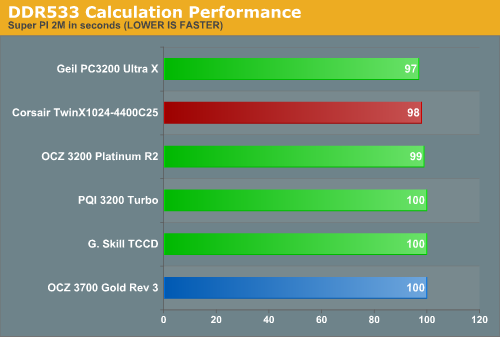
Intel Highest Memory Speed Performance
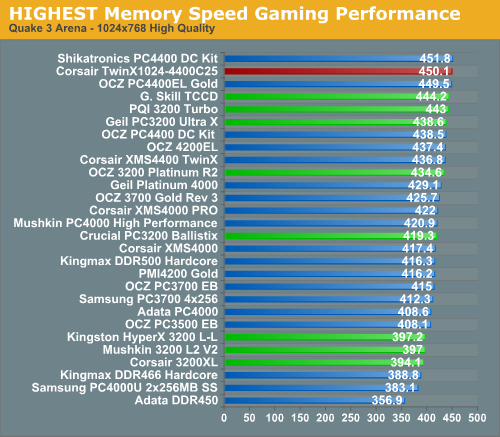
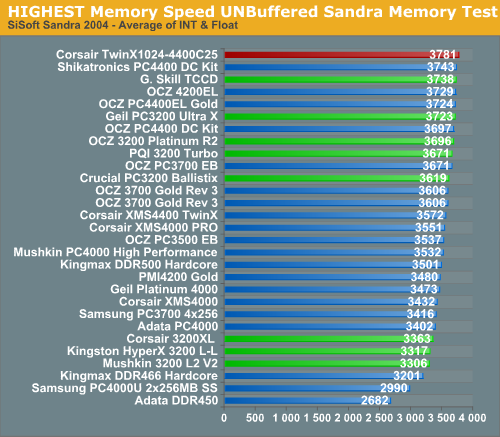

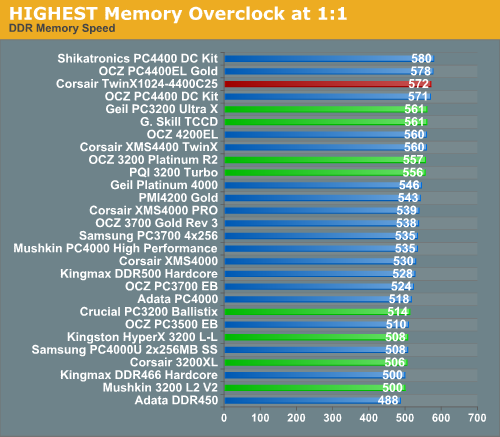
Final Words
The Corsair TwinX1024-4400C25 was an outstanding performer in our benchmarks. This was particularly true on the AMD Athlon 64 platform, where Corsair set new records for top memory speed, top 1T Command Rate memory speed, and Top Performance. The Corsair DDR550 is clearly geared to best performance at the top of the memory charts and it succeeds in reaching that goal.However, this fantastic top-end performance by the Corsair was not without some minor compromise, at least in the DIMMs that we tested. DDR400 performance of the Corsair was nothing special, with a number of other excellent TTCD memory modules outperforming Corsair at DDR400. It certainly appears in binning TCCD chips that the memory, which reaches the very top in memory speeds, is not the same TCCD that performs best at DDR400. However, the real performance penalty at DDR400 is really quite small.
Performance was similar on the Intel memory test bed, but we did not see the dominating performance on Intel that Corsair achieved on the AMD Athlon 64 test platform. On both platforms, below DDR466, there are other Samsung TCCD-based memories that will outperform Corsair. OCZ, G. Skill, and Geil in particular are clearly faster below 466. However, by the time that we reached 466 in the benchmarks, the Corsair TwinX1024-4400C25 was our new performance leader. The further that we went up the memory speed scale, the wider the lead for Corsair. This is mostly due to the aggressive timings possible with Corsair DDR550 at the higher memory speeds, since performance is otherwise the same as other TCCD that we have tested. For example, Corsair required 2-3-3 timings at DDR400, but those same DDR 2-3-3 timings still worked well at DDR500.
If you want the fastest DDR memory that you can buy for the AMD platform, then the Corsair is your choice, although the real performance increase over other top TCCD is very small. The Corsair reaches the highest levels of performance at the top, but with compromises in the DDR400 to 466 range compared to other top TCCD. We think that the compromises are justified, based on how very well the Corsair did at the top. We wondered if we might ever reach DDR600 in our AMD benchmarks, and Corsair blew past that with DDR610 at 1T and continued on to DDR638 at a 2T Command Rate. It even settled in with decent timings, 1T, and top performance at DDR590 - the fastest that we have seen.
For the fastest memory speeds possible, Corsair TwinX1024-4400C25 is your choice. For best performance at DDR400 to DDR466, almost any other Samsung TCCD module will do a little better. For DDR400 at 2-2-2 and top-end performance a bit shy of this extraordinary Corsair memory, you can choose Geil PC3200 Ultra X, Crucial PC3200 Ballistix, OCZ PC3200 Platinum Rev.2, PQI 3200 Turbo, or G. Skill TCCD. Your choice depends on exactly where you want to go with memory on your computer.







